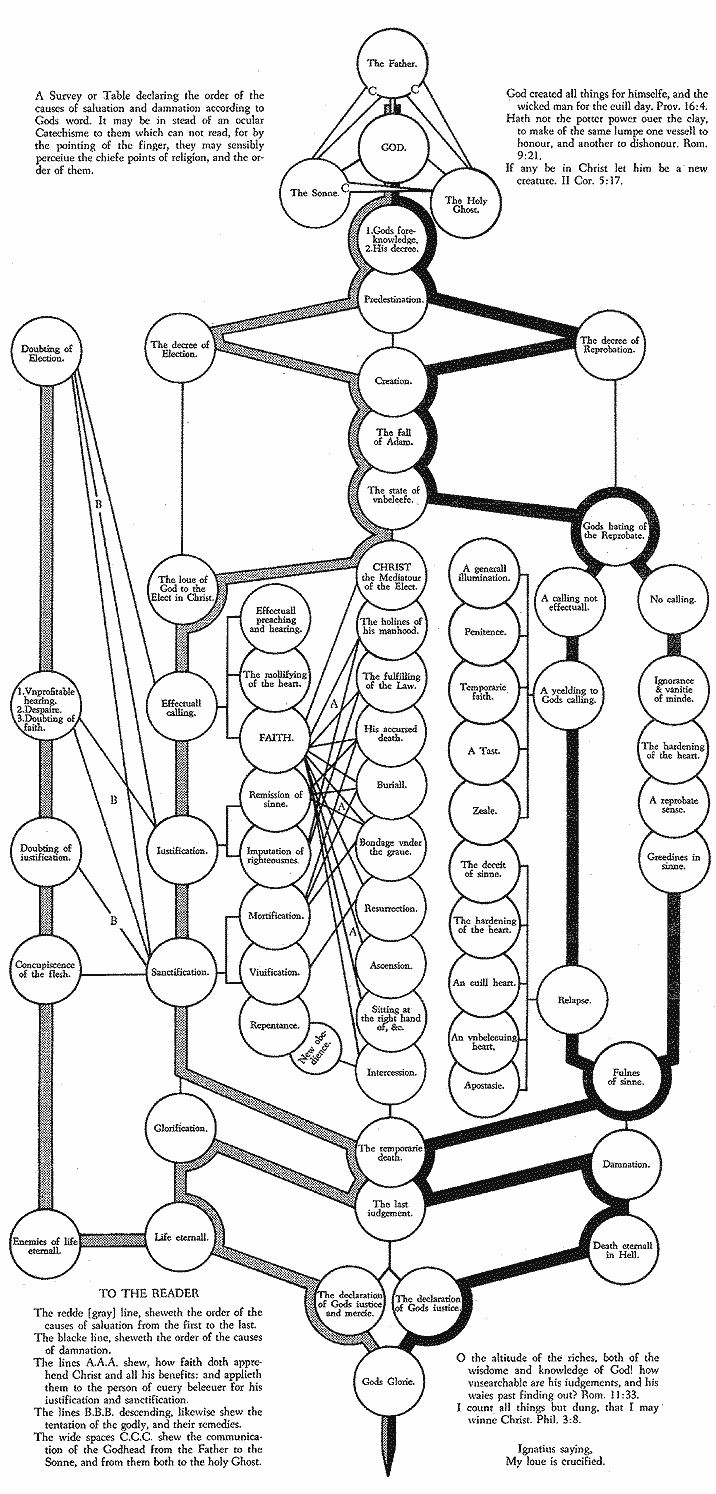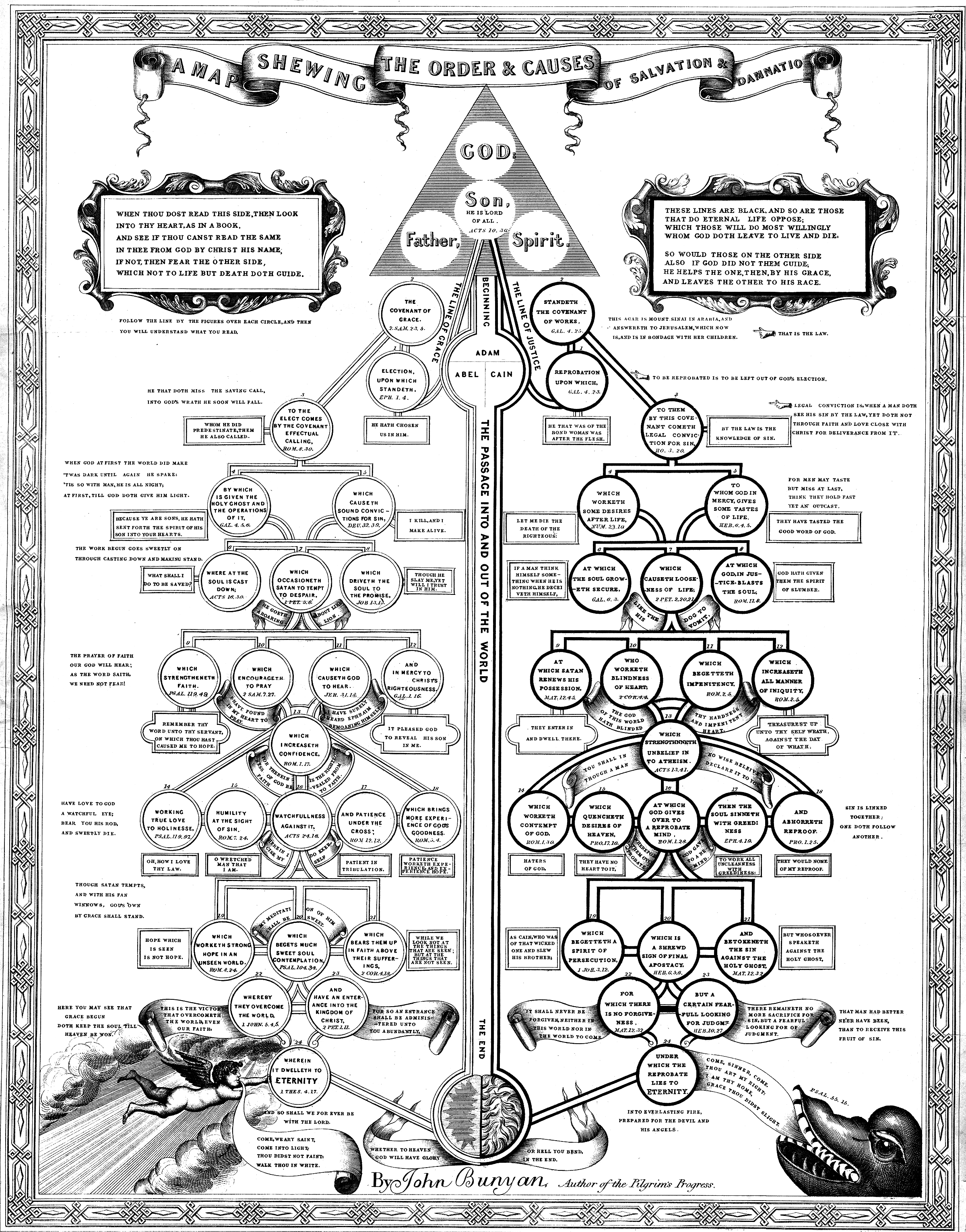12 Bible Doctrine – Have Calvinists Diagramed Their Framework Of Doctrine?
A Transcript Of The Video Study
Yes, many Calvinists have attempted to illustrate the way in which they understand the framework of sovereign grace. For this study, I would like to show you two of the more well known diagrams, both of which were produced more than three hundred years ago. The first was drawn up by a man named William Perkins.
1. William Perkins (1558–1602)
William Perkins was a student and then professor at Cambridge University. He became one of the leading Puritans in the Church of England during the Elizabethan era. His writings gained such popularity that they even surpassed the sales of John Calvin. He wrote almost 50 books, which is quite an achievement, considering he died at the early age of 44. It was an unexpected death. His second wife was expecting his seventh child, when he fell ill and died of “the stone”, before she gave birth.
In 1591, at the age of 33, he published a book called, “A Golden Chain”. As the extended title explains, it is “the description of theology: containing the order of the causes of salvation and damnation, according to God’s word. A view of the order whereof, is to be seen in the table annexed.” This ‘table’ was Perkins’ attempt to diagram his framework of doctrine.
At first, the diagram looks quite complex and bewildering. But don’t fret. A closer examination will vindicate its simplicity and clarity. At the top is the TriUne Jehovah and everything He does leads to His own glory.
The purpose of the diagram is stated on the top left hand corner:
“A survey or table declaring the order of the causes of salvation and damnation according to God’s Word. It may be in stead of an ocular Catechism to them which cannot read, for by the pointing of the finger, they may sensibly perceive the chief points of religion, and the order of them.”
An explanation of the diagram is given on the bottom left hand corner:
“To The Reader
First,
“The red (grey) line, shows the order of the causes of salvation from the first to the last.”
That red (or grey) line is positioned on the left side of the diagram. It connects the various doctrines of the gospel, showing their order and unity. You notice, it all begins with predestination and God’s decree of election. Henceforth, the blessings of salvation are designed for and made available only to God’s elect people.
Second,
“The black line, shows the order of the causes of damnation.”
The black line is positioned on the right side of the diagram. It connects the various teachings associated with false religion and false professions of faith. You notice, it all begins with predestination and God’s decree of reprobation. Henceforth, though the non-elect are blessed with existence and all the joys and benefits of life on earth, yet the blessings of salvation are not designed for them, nor should they be offered to them. Whereas God has commissioned the gospel be preached to all sinners (elect and non-elect), yet He has never sanctioned the gospel be offered to anyone. It is not ours to offer. It is God’s to give. And He gives the free gift of salvation to those He has set apart as special objects of His love, by the effectual power of the Holy Spirit.
Third,
“The lines A.A.A., show, how faith does apprehend Christ and all His benefits: and applies them to the person of every believer for his justification and sanctification.”
These lines are found on the left side of the diagram, interconnecting the various doctrines of the gospel with the Person and work of the Lord Jesus Christ.
Fourth,
“The lines B. B. B., descending, likewise show the temptation of the godly, and their remedies.”
These lines are also found on the left side of the diagram, interconnecting the various temptations God’s regenerate people suffer, and how the Lord delivers them from their troubles.
Fifth,
“The wide spaces C.C.C., show the communication of the Godhead from the Father to the Son, and from them both to the Holy Ghost.”
These spaces are found at the top of the diagram, linking together the Persons of the TriUne Godhead.
Henceforth, the diagram as a whole begins with the TriUne Jehovah and His eternal decree, linking together God’s plan for the human race—on the left side of the diagram is God’s plan for the elect; on the right side is His plan for the non-elect. And it all leads to the glory of God.
Listed on the top and bottom right hand corners are a list of scriptures supporting Perkins’ framework of teachings:
“God created all things for Himself, and the wicked man for the evil day.”—Proverbs 16:4
“Hath not the potter power over the clay, to make of the same lump one vessel unto honor, and another to dishonor.”—Romans 9:21
“If any be in Christ let him be a new creature.”—2 Corinthians 5:17
“O the altitude of the riches, both of the wisdom and knowledge of God! How unsearchable are His judgments, and His ways past finding out?”—Romans 11:33
“I count all things but dung, that I may win Christ.”—Philippians 3:8
And then Perkins concludes with a quote from an early Christian writer named Ignatius:
“Ignatius saying, ‘My love is crucified.’”
Now, it is not my purpose to examine the details of this diagram. My only aim has been to show you that William Perkins, a 16th century High-Calvinist, produced a diagram illustrating his framework of doctrine. And he wasn’t alone. Several years before Perkins illustrated his teachings, the great Reformer Theodore Beza, drew up a similar diagram for his understanding of God’s masterplan for the ages. In fact, Perkins makes reference to Beza’s diagram on the title page of his theology book—“Hereunto is adjoined the order which Mr. Theodore Beza used in comforting afflicted consciences.” Of course, Perkins’ diagram includes far greater detail than that of Beza’s, but it is quite evident that Perkins based his framework of teachings upon that of Beza’s.
But then, between 60-70 years after Perkins published his diagram, another Calvinist did the same thing. His name was John Bunyan.
2. John Bunyan (1628-1688)
John Bunyan is a name that should be familiar to most of us. Although we know him best for his “Pilgrim’s Progress”, yet he was actually a prolific writer, authoring close to sixty books. Among these writings is a diagram illustrating his framework of teachings.
He called the diagram, “A Map Showing The Order And Causes Of Salvation And Damnation.” As you can see, it looks quite similar to that of Perkins’ diagram. Just as Perkins based his diagram upon that of Beza’s framework, so it appears Bunyan based his diagram upon that of Perkins and Beza.
The TriUne Jehovah appears at the top, with everything else leading to the glory of God—
“Whether to heaven or hell you send, God will have glory in the end.”
An explanation of the diagram is given on the top right and left corners.
On the top left side, Bunyan writes:
“When thou dost read this side, then look
Into thy heart, as in a book,
And see if thou canst read the same
In thee from God by Christ His name,
If not, then fear the other side,
Which not to life but death doth guide.”
On the top right side, Bunyan writes:
“These lines are black, and so are those
That do eternal life oppose;
Which those will do most willingly
Whom God doth leave to live and die.
So would those on the other side
Also if God did not them guide,
He helps the one, then, by His grace,
And leaves the other to His race.”
As a whole, Bunyan begins with the TriUne Jehovah, then divides the human race between the elect and the non-elect, immediately highlighting the significance and distinction between the Covenant of Grace and the Covenant of Works.
Again, it is not my purpose to look at the details of this diagram. I am only showing you that there have been Calvinists to diagram their framework of doctrine. The diagrams of Perkins and Bunyan are among the most well known illustrative resources of this kind. And of course, they certainly serve as a counter-framework to that of the Arminians. In fact, it would be a good exercise on your part if you were to compare the Arminian diagrams we looked at last week, with these two Calvinist diagrams. Compare the Romans Road to salvation with the frameworks of Perkins and Bunyan. Compare the Gospel Bridge with the frameworks of Perkins and Bunyan. Compare the Dispensational Timeframe with the frameworks of Perkins and Bunyan. You will discover a clear difference between them. To that end, I would like to encourage you to obtain a digital or printed copy of Perkins and Bunyan’s complete works. Each of them has had his writings compiled in three volumes, and the PDF’s can be downloaded online for free.
Well, my dear friends, this brings us to the end of the study. I look forward meeting with you again next time, when we will consider the question—Have You Diagramed Your Framework Of Doctrine? Until then, may you know the Lord’s blessings.
Jared Smith served twenty years as pastor of a Strict and Particular Baptist church in Kensington (London, England). He now serves as an Evangelist in the Philippines, preaching the gospel, organizing churches and training gospel preachers.
Jared Smith on Eldership
Jared Smith on the Biblical Covenants
Jared Smith on the Gospel Law
Jared Smith on the Gospel Message
Jared Smith on Various Issues
Jared Smith, Covenant Baptist Church, Philippines
Jared Smith on Bible Doctrine
Jared Smith on Bible Reading
Jared Smith's Studies in Romans
Jared Smith's Hymn Studies
Jared Smith's Maternal Ancestry (Complete)
Jared Smith's Sermons






